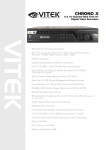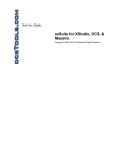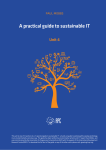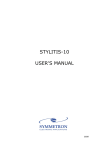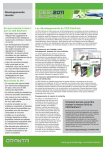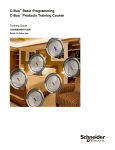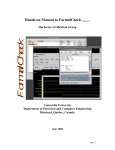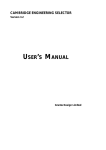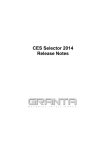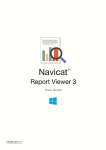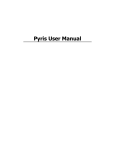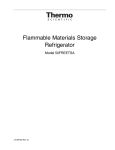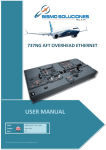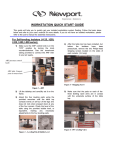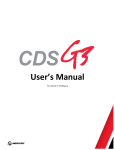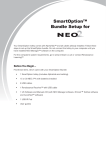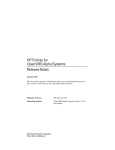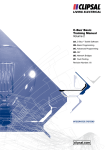Download CES EduPack 2015 Getting Started Guide
Transcript
CES EduPackTM 2015 CES EduPack User Manual and Getting Started Guide February 2015 CES EduPack User Manual and Getting Started Guide 2 Contents 1 Overview . . . . . . . . . . . . . . . . . . . . . . . . . . . . . . . . . . . . . . . . . . . . . . . . . . . 3 1.1 Where to Find Help 3 2 Installation . . . . . . . . . . . . . . . . . . . . . . . . . . . . . . . . . . . . . . . . . . . . . . . . . . 5 2.1 Introduction 2.2 Licensing 2.3 Running the Setup Program 5 5 6 3 Databases . . . . . . . . . . . . . . . . . . . . . . . . . . . . . . . . . . . . . . . . . . . . . . . . . . 7 3.1 Databases for Rational Materials Selection 7 4 Getting Started with CES EduPack . . . . . . . . . . . . . . . . . . . . . . . . . . . . . . 9 4.1 Brief Description of CES EduPack 4.2 Browsing and Searching 4.3 Material Selection 4.4 Process Selection 4.5 Saving, Copying, and Report Writing 4.6 Eco Audit 4.7 Hybrid Synthesizer 9 10 17 23 24 25 31 5 Toolbars and General Information . . . . . . . . . . . . . . . . . . . . . . . . . . . . . . 34 5.1 Legal and Acknowledgments 37 CES EduPack User Manual and Getting Started Guide 3 1 Overview CES EduPack supports and enhances the teaching and learning of materials, engineering, design and sustainability. It provides a comprehensive database of materials and process information, powerful materials software tools, and a range of supporting textbooks, lectures, projects, and exercises. With specialist Editions for specific disciplines, and three levels of the database and software to suit varying needs in all years of undergraduate study and postgraduate teaching, EduPack is a curriculumwide resource. It is continually developed based on feedback from the global user community. The CES EduPack software provides engaging ways for students to explore and understand the world of materials. • Become familiar with materials space—with powerful tools to browse and search the information in CES EduPack databases. • Visualize properties—charting tools help to develop understanding of how material families behave. • Match materials to applications—for example, by applying a structured approach to materials selection; helps students to relate their learning to the world around them. • Dig into the underlying science—encourage students to get to grips with the scientific principles through textbook-style 'science note' information and textbook links. • Evaluate environmental impact with the Eco Audit Tool—explore key eco design concepts; try 'what if' scenarios. • Additional tools are also available, such as the innovative Hybrid Synthesizer which allows investigation into the benefits of using hybrid materials. 1.1 Where to Find Help You will be surprised at all the additional help and resources that can be accessed from CES EduPack. Getting Started The Installation Guide is the starting point for anyone that has not yet installed CES EduPack. If you have any questions or issues at this stage, you can refer to our Student FAQs. Or the Educator FAQs. CES EduPack User Manual and Getting Started Guide Learning How EduPack Works The User Manual and Getting Started Guide, as well as the Video Tutorials, are the best way to learn about the core functionality of the software. The In-Software Help is accessed from the Help menu, or by pressing the F1 key. As well as explaining the core functionality, it also includes useful references like the Tables of Materials Indices and glossaries of materials terms. Further Learning The Case Studies were created by Professor Mike Ashby and follow the material selection methodology outlined in his book, Material Selection for Mechanical Design. They can be completed using CES EduPack. You can find interactive case studies to practice your skills, ready-made Eco Audit project files, and fun databases on Granta’s Teaching Resources Website. The online books CES InDepth and CES EduPack Concepts explain the concepts of selection methodology and the CES EduPack databases. 4 CES EduPack User Manual and Getting Started Guide 5 2 Installation 2.1 Introduction This part of the User Manual provides instructions for registering and installing your copy of the CES EduPack system. System Requirements To run the CES EduPack software you will need: • A compatible Microsoft® Windows® operating system; Windows XP 32-bit SP3, Windows Vista 32-bit or 64-bit SP2, Windows 7 32-bit or 64-bit, Windows 8 32-bit or 64-bit. • 4 GB of RAM. • 4 GB of available hard disk space. • Internet connection (for the Web Search functionality). • Microsoft .NET Framework version 4.0 and ReportViewer 2010 SP1. For the French language installation you will also require the French language packs for both of these. If any of these are not already installed, you will be given the option to add them to the CES EduPack installation process. • Administrator rights. 2.2 Licensing Students If you are a student installing this on your own computer then you do not need a license key. You have been given the files to install CES EduPack, either on a DVD or via a link to a network etc. Check that you have been given a file called info.dat and that it is in the same folder as setup.exe. If not, please ask your instructor for this file. For the Student FAQ page please go to www.grantadesign.com/education/support/FAQs/students.htm. Educators - Enrollment License If you have an enrollment license - a time limited license for a group of students - then you need to make sure that you have been given a file called info.dat and that it is in the same folder as setup.exe. You do not need a license key. If you do not have this file, please ask your IT administrator or contact Granta Design. Educators - Lab License If you are setting up a perpetual or lab license, where the software is installed on a number of fixed computers, then you will need a license key. You will find this in on your software license agreement. For the Educators FAQ page please go to www.grantadesign.com/education/support/FAQs/ educators.htm. Network Administrators Please follow this link for information on installing the software over a network - www.grantadesign.com/ education/network. For the Network Administration FAQ page please go to www.grantadesign.com/education/support/ FAQs/network.htm. CES EduPack User Manual and Getting Started Guide 2.3 Running the Setup Program If you have installed a previous version of CES EduPack, we recommend that you uninstall it before installing this version. To do so, use Add or Remove Programs in Windows Control Panel. To install the software, run setup.exe and follow the instructions in the installation wizard. You can use Cancel or Exit Setup to quit the installation when they are displayed. You can find a video of the installation process at www.grantadesign.com/education/resources/ videotutorials. 6 CES EduPack User Manual and Getting Started Guide 7 3 Databases Different databases are available depending on your installation. The databases are split into Introductory - Level 1 and 2 databases, and Advanced - Level 3 databases, with different editions to cover specific areas of study e.g. Aerospace and Sustainability. There are video Database Tours, to give you more information on the different levels and databases: http://www.grantadesign.com/education/resources/videotutorials/2015/index.htm. 3.1 Databases for Rational Materials Selection The MaterialUniverse and ProcessUniverse data modules are used with CES EduPack to create high quality databases. They are designed for like-to-like comparisons across the whole spectrum of material and processing possibilities. Typical material databases do not allow this - the most common reasons being: 'holes in the data'; and different properties reported for different materials. This makes it difficult to compare different classes of materials. Universe data modules solve the problem by conforming to strict database design principles. These principles are reviewed below, with reference to the MaterialUniverse data module. Complete spectrum represented The MaterialUniverse data module contains a representation of virtually every commercial engineering material in every class. This means that you can be sure that you have considered all material possibilities for any particular application. Each material represented only once Multiple instances of the same material from different producers are consolidated into one representative record. This reduces the complexity of the engineer's search for the best material. Property ranges Properties of real materials are seldom exact - there are inevitable variations from batch to batch and manufacturer to manufacturer. These variations are captured in a Universe data module by a range the range may be small for a property such as density, but relatively large for price or toughness. Complete property set In a Universe data module, there is a value for every property on the datasheet. If the value is not known experimentally, it has been estimated by using intelligent estimating techniques based on wellestablished correlations between material properties, using their fundamental physics. These estimated values are denoted by a * in the datasheet. Quality checks Granta has examined hundreds of material datasets over the years from various sources and, without exception, they contain errors - sometimes by as much as 1000%! To minimize errors in the Universe data modules, strict data checking procedures are used. These include checks that properties for specific material classes fall within acceptable ranges, and powerful science-based checks on the correlations between properties. Normalization All properties are presented in the same unit system, which can be chosen by the user. Properties that are reported in different ways for different materials classes are equivalenced to enable comparison. Hierarchy The carefully-constructed record hierarchy allows simple and rapid navigation to all records in the data module. The Result Applying these principles required a great amount of work in data collection and processing. The MaterialUniverse data module represents over 50 man-years of effort spread over a 15-year period. CES EduPack User Manual and Getting Started Guide 8 The rewards of this effort are immediate and numerous with the MaterialUniverse and ProcessUniverse databases used in combination with the CES EduPack software. References The reference source is given at the bottom of the datasheet, to encourage students to question and research where the data comes from. CES EduPack User Manual and Getting Started Guide 9 4 Getting Started with CES EduPack The following exercises give an overview of CES EduPack and will teach you how to use the core functionality. The exercises in Chapter 5 go into further detail and explore some of the software’s more specialized features. There is also comprehensive help file within the software that gives more detailed guidance, as well as case studies with loadable project files. 4.1 Brief Description of CES EduPack The main tools in CES EduPack are: • BROWSE Explore the database and retrieve records via a hierarchical index or tree. • SEARCH Find information via a full-text search of records. • SELECT The central hub of CES EduPack, used to apply the Rational Material Selection methodology. A powerful selection engine that identifies records that meet an array of design criteria and enables trade-offs between competing objectives. • CHART Create charts and add formatting and labels to illustrate your point. • ECO AUDIT Quickly estimate the environmental impact of a product over its entire lifecycle and study What If design scenarios. The enhanced version also accounts for Secondary, Joining, and Finishing processes, and allows you to apply the same What If scenarios to the economic cost. • HYBRID SYNTHESIZER Explore the benefits of using different hybrid materials and structures; predict material performance and compare with standard materials. The following exercises cover the use and functionality of these tools. CES EduPack User Manual and Getting Started Guide 10 4.2 Browsing and Searching Exercise 1 Opening the Database If you have more than one database installed, CES EduPack will show the Databases dialog. The following exercises use the MaterialUniverse and ProcessUniverse tables, which are part of every Granta database. The Edition Homepage will open, showing a list of the available tables and a graphic for each subset. Click on a subset name to show its description. Use the information icon next to the database name to show a detailed description. • Swap between the available subsets and see how they have different applications and data Click on a subset in the Edition Homepage to select it. The information displayed is for the currentlyselected subset. Notice that the Browse tree in the left pane updates to the currently selected subset. • Change to the PROCESSUNIVERSE table Click on ProcessUniverse and notice that the Browse tree in the left pane updates to show the new table. • CLOSE the HOMEPAGE Click on the cross at the top of the Homepage tab. This page can be reopened at any time from View menu - Home. CES EduPack User Manual and Getting Started Guide 11 • Change to the MATERIALUNIVERSE table With the Homepage closed, navigate to different tables using the Table drop-down in the Browse pane. Browse Search Table: MaterialUniverse Subset: All materials Select There are also links to online resources, for both students and educators, from the homepage. CES EduPack User Manual and Getting Started Guide 12 Exercise 2 Browse Materials Browse Search Table: MaterialUniverse Subset: All materials Select MaterialUniverse Ceramics and glasses Fibers and particulates Hybrids: composites, foams etc. Metals and alloys Polymers: plastics, elastomers Select the Table MaterialUniverse and the Subset All materials. • Find a record for STAINLESS STEEL • Find a record for CONCRETE • Open the GENERIC record for POLYPROPYLENE Generic records are records at the folder level and give general information on the material, rather than data on a specific variant. Generic records have their own icon . Double-click to open. • Open a POLYPROPYLENE record Double-click on the record name in the tree Click on hyperlinked attribute names. In Level 1 and Level 2 databases, this will bring up a Science Note, giving details of the underlying science and calculations for the attribute. In Level 3 databases, this will bring up the design note, which provides background information on properties, test notes, and selection guidelines. From a design note, there will also be a link to the corresponding Science Note. Right-click on the datasheet to see a context menu with further actions e.g., locate in Browse tree, copy the datasheet, print the datasheet, export the data to an FE package format. CES EduPack User Manual and Getting Started Guide The design note for Young’s modulus: Young's modulus Stiffness in tension (also called Tensile Modulus, Elastic Modulus, Modulus of Elasticity). Test notes Young's modulus (E) is the slope of the initial linear-elastic part of the stress-strain curve in tension. Material selection notes Use to select materials with sufficient stiffness (high value) or sufficient compliance (low value). Modulus in tension, flexure, and compression are similar for most materials so can be interchanged for approximate work. Typical values: Flexible plastics and elastomers Unfilled plastics Reinforced plastics Ferrous metals Non-ferrous metals Technical ceramics Ceramics and glasses < 1 GPa 1–4 GPa 5–25 GPa 70–250 GPa 10–310 GPa 20–700 GPa 1–120 GPa Click to see science note. The corresponding Science Note from Level 3: 13 CES EduPack User Manual and Getting Started Guide 14 Part of a datasheet for the material Polypropylene: • Find PROCESSES that can shape POLYPROPYLENE using the ProcessUniverse LINK at the bottom of the datasheet. CES EduPack User Manual and Getting Started Guide 15 Exercise 3 Browse Processes Browse Search Table: ProcessUniverse Subset: All processes Select ProcessUniverse Joining Shaping Surface treatment Browse ProcessUniverse: All processes • Find a record for INJECTION MOLDING • Find record for LASER HARDENING • Find record for FRICTION WELDING (METALS) • Find materials that can be DIE CAST, using the LINK at the bottom of a record for DIE CASTING CES EduPack User Manual and Getting Started Guide 16 Exercise 4 The Search Facility • Find the material POLYLACTIDE Browse Search Select Polylactide The search term is highlighted in records opened from the search results. • Find the materials for CUTTING TOOLS • Find the process RTM Note: The folder name is also included in the search. If the term appears in a folder name, all records under that folder will be returned; for example, a search for ceramic would return all records in the folder named Ceramic. Wildcards are automatically added to the end of each search term. • Enter the search term ALUM Records for or containing Alumina and Aluminum are returned. • The following search operators are available: AND Finds records containing both the search terms, so steel AND alloy returns only records containing both the words steel and alloy OR Finds records containing either search term, so steel OR alloy returns all records that contain steel, alloy, or both NOT Finds records containing the first search term, but not the second, so steel NOT alloy returns only records with the word steel but without the word alloy Phrase Search Finds the exact search term, so “steel alloy” will return only records containing the exact phrase steel alloy Parentheses Used to group search terms, so iron AND (ore OR cast) will return the records containing iron and containing either ore, cast, or both Wildcards Use ? as a wildcard single character, or * as a wildcard representing any number of characters (cannot be used as the first character in a search string) Note: AND operators are automatically added when a search has two or more terms and no other operators have been entered. CES EduPack User Manual and Getting Started Guide 17 4.3 Material Selection Exercise 5 Selection Using a Limit Stage • Find materials with: MAX. SERVICE TEMPERATURE > 200 °C THERMAL CONDUCTIVITY > 25 W/m.°C ELECTRICAL RESISTIVITY > 1e15 μohm.cm Browse Search Select 1. Selection Data Limit stage MaterialUniverse: All bulk materials Mechanical properties 2. Selection Stages Thermal properties Graph/Index Limit 3. Results X out of Y pass Tree Min Max Max. service temp. 200 °C Thermal conductivity 25 W/m.K J/kg.K Specific heat capacity Rank by: Property A Material 1 2130 Material 2 2100 Material 3 1950 Material 4 1876 etc. Electrical properties Min Electrical resistivity 1e15 Max ohm. cm Ceramics and glasses Limit guidance bars Composites Metals and alloys Polymers and elastomers 1 1E+8 1E+20 Use the limit bars for guidance on suitable values. Enter the limits – minimum or maximum as appropriate – and click Apply. If a reference record is set, its values for each property will be shown to the right of the min/max entry boxes. Example results: Aluminum nitride, Alumina, Silicon nitride. Some properties have discrete values, rather than numeric ranges. • Edit this limit stage and search for materials with non-opaque TRANSPARENCY. Under Optical Properties, refine by transparency using the drop-down and tick Translucent, Transparent, and Optical quality. Click Apply. Example results: Alumina (translucent) and Diamond. • DELETE THIS STAGE CES EduPack User Manual and Getting Started Guide 18 Exercise 6 Selection Using a Graph Stage When plotted on a Graph Stage, records can also be filtered using the charting Box and Line Selection tools. This provides a more qualitative approach to filtering. • Make a BAR CHART of YIELD STRENGTH (σy) Set the y-axis to Yield strength (elastic limit). Browse Search Select 1. Selection Data Bar chart MaterialUniverse: All bulk materials Graph/Index Limit Tree Yield strength 2. Selection Stages Bubble chart Rank by: Property A Material 1 2130 Material 2 2100 Material 3 1950 Material 4 1876 Yield strength 3. Results X out of Y pass Box selection Line selection Density etc. • Use a BOX SELECTION to find materials with high values of YIELD STRENGTH Click Box Selection , then click-drag-release to define the box. • Add DENSITY (ρ) to the other axis Either: highlight Stage 1 in Selection Stages, right-click and choose Edit Stage from the menu; or double-click the axis to edit. • Use a BOX SELECTION to find materials with high STRENGTH and low DENSITY • Use a LINE SELECTION to find materials with high values of the specific strength σy / ρ Click Gradient-Line Selection , then enter slope in the dialog, in this case 1. Click on the graph to position the line through a particular point. Click above or below the line to select an area, in this case above the line for high values of σy / ρ. Drag the line upwards to refine the selection to fewer materials. CES EduPack User Manual and Getting Started Guide Selection box Selection line, slope 1 Selection line, slope 1 • Rank the results by specific strength (YIELD STRENGTH / DENSITY) Rank by Stage 1: Performance Index and click on results column to reverse the order. Example results: CFRP, Titanium alloys, Magnesium alloys. • DELETE ALL STAGES Using a Tree Stage, records can be filtered based on their links to records in other data tables, or based on the database hierarchy (tree). 19 CES EduPack User Manual and Getting Started Guide 20 Exercise 7 Selection Using a Tree Stage • Find materials that can be MOLDED In the Tree Stage window, select ProcessUniverse, navigate to Molding, and click Insert followed by OK. Browse Search Select 1. Selection Data MaterialUniverse: All bulk materials Tree stage for material Ceramics Steels 2. Selection Stages Graph/Index Limit Tree Material Hybrids Al alloys Metals Cu alloys Polymers Ni alloys... 3. Results X out of Y pass Tree stage for process Cast Material 1 Material 2 Material 3 Material 4 etc. Join Process Shape Surface Deform Mold Composite Powder Prototype • DELETE THIS STAGE • Find processes to join STEELS Select Processes: Joining processes. In the Tree Stage window, select MaterialUniverse, expand Metals and alloys in the tree, select Ferrous, and click Insert followed by OK. • DELETE THIS STAGE CES EduPack User Manual and Getting Started Guide 21 Exercise 8 Combining Filtering and Charting Tools Select Level 3 MaterialUniverse: All bulk materials. • Find materials with: DENSITY < 2000 kg/m^3 STRENGTH (Elastic limit) > 60 MPa THERMAL CONDUCTIVITY < 10 W/m.°C Add a Limit Stage with three criteria. • Filter the results to find those that can be THERMOFORMED Add a Tree Stage and select ProcessUniverse - Shaping - Molding. • Rank the results by PRICE Add a Graph Stage with a bar chart of Price. On the Graph Stage, all materials that fail one or more stages are grayed out. The Results pane shows the materials that pass all stages. Example results, lowest PRICE first: PET-GF, PLA, PET ... Browse Search Select 1. Selection Data MaterialUniverse: All bulk materials Stacked stages Cast Deform Join Process 2. Selection Stages Mold Shape Composite Surface Graph/Index Limit Powder Tree Prototype Min Density Yield strength Intersection of all stages X out of Y pass Material 1 Rank by: Property A 2130 Material 2 2100 Material 3 1950 Material 4 1876 etc. Price 3. Results T-conductivity Max 2000 60 10 CES EduPack User Manual and Getting Started Guide Exercise 9 Finding Supporting Information The following exercise requires an Internet connection. CES EduPack translates the material ID to search strings compatible with a group of high-quality material and process information sources and delivers the hits. Many of the sources require a subscriber-based password. The ASM source is particularly recommended. • Search the web to find more information on PET With the PET datasheet open, click on Search Web. 22 CES EduPack User Manual and Getting Started Guide 23 4.4 Process Selection Exercise 10 Selecting Processes Select Level 3 ProcessUniverse: Shaping processes. • Find PRIMARY SHAPING PROCESSES to make a component that has: SHAPE Dished sheet MASS 10 - 12 kg SECTION THICKNESS 4 mm ECONOMIC BATCH SIZE > 1000 Add a Limit Stage with five criteria. • Refine this search to only include THERMOPLASTIC materials Add a Tree Stage and select MaterialUniverse - Polymers - Plastics - Thermoplastics. Example results: Thermoplastic composite molding, Spray-up, Rotational molding, Compression molding. Browse Search Select 1. Selection Data ProcessUniverse: Shaping processes 2. Selection Stages Graph/Index Limit Tree Shape Dished sheet Ceramics Hybrids Material Physical attributes Mass range 10 12 kg Range of section thickness 4 4 mm Process characteristics Primary shaping processes Economic attributes Economic batch size (units) 1000 Metals Polymers Elastomers Plastics Thermoplastics Thermosets CES EduPack User Manual and Getting Started Guide 24 4.5 Saving, Copying, and Report Writing Exercise 11 Saving, Exporting, and Copying • Save the project Go to the File menu - Save Project. Give the project a filename and directory location; the project will be saved with the file extension .ces. Charts, records, and results lists can be copied and pasted into a word processing application. • Generate a chart. Copy and paste the chart into a document Click on the chart. Either: right-click on the chart and select Copy; or press CTRL+C to copy the chart to your clipboard. Paste from your clipboard to the document. • SEARCH for a record and display the datasheet. Copy and paste the datasheet into a document • GENERATE a RESULTS list using SELECT. Copy and paste the full list into a document Right-click in Results and click Select all. Either: right-click on the highlighted list and select Copy; or press CTRL+C once the list has been highlighted. • Copy individual results from the results list into a document Use SHIFT+click or CTRL+click to highlight selected records. • Try editing the document you have created CES EduPack User Manual and Getting Started Guide 25 4.6 Eco Audit The Eco Audit Tool estimates the energy used and CO2 produced during five key life phases of a product (material, manufacture, transport, use, and end of life) and identifies which is the dominant phase. This is the starting point for eco-aware product design, as it identifies which parameters need to be targeted to reduce the eco-footprint of the product. A brand of bottled mineral water is sold in 1 liter PET bottles with polypropylene caps. A bottle weighs 40 grams; the cap 1 gram. Bottles and caps are molded, filled, and transported 550 km from the French Alps to England by 14 tonne truck, refrigerated for 2 days and then sold. The overall life of the bottle is one year. An example product file for this case study is installed with CES EduPack in the Samples folder, with the filename Bottle mineral water.prd. Browse Search Select Tools Eco Audit Product Definition The following details how the example product file has been created. Eco Audit Project New Open Save Compare with ... Product Information Name: PET Bottle Bottle For an explanation of the calculations used at each stage, click the Help icon in the heading. CES EduPack User Manual and Getting Started Guide 26 1. Material, manufacture, and end of life Bill of materials (BoM) and primary processing techniques. Quantity 100 Component name Bottle Material Recycle content PET MaterialUniverse Ceramics and glasses Primary process Mass (kg) End of life 0% Molding 0.04 Recycle 0% Molding Landfill 100% Extrusion Combust Hybrids: composites etc Downcycle Metals and alloys Recycle Polymers and elastomers Re-engineer Elastomers Reuse Polymers Thermoplastics PET 100 Cap 100 Water PP 0% Molding 0.001 Combust 1 2. Transport Transportation from site of manufacture to point of sale. Stage Name Transport type BottlingBottle plant to point of sale Molding 14 tonne truck Sea freight Rail freight 14 tonne truck Air freight – long haul ... 3. Use Product Life and Location Use Product life: 1 Country electric mix: years Molding Kingdom United France Germany United Kingdom ... Distance (km) 550 Bottle CES EduPack User Manual and Getting Started Guide 27 Static Mode Energy used to refrigerate product at point of sale (average energy required to refrigerate 100 bottles at 4°C = 0.12kW. Product uses the following energy: Energy input and output: Molding to mechanical (electric motors) Electric Power rating: 0.12 Usage: 2 days per year Usage: 2 hours per day kW Fossil fuel to thermal, enclosed system Fossil fuel to electric Electric to thermal Electric to mechanical (electric motors) ... 4. Report Molding Summary chart enables rapid identification of the dominant life phase. Toggle between views of energy usage or CO2 footprint. Energy CO2 CES EduPack User Manual and Getting Started Guide 28 The chart shows that, in this project, Material is the dominant life phase. Each life phase can be clicked to show guidance on strategies to reduce its impact. Molding Detailed report provides a component by component breakdown of each life phase, enabling the main contributors to the dominant life phase to be identified. CES EduPack User Manual and Getting Started Guide 29 Exercise 12 Compare Eco Audits • Create a copy of the current product for comparison Click Compare with and select Copy of current product. Eco Audit Project Product Definition New Open Save Compare with ... Copy of Current Project New product Saved product ... • Set the following values in for the new product: NAME PET Bottle (Recycled) RECYCLED CONTENT 35% • Generate the SUMMARY CHART The first life energy (not including EoL potential) is reduced by 16%. Note: The chart can be copied into a document or printed using Copy and Print at the top of the chart window. CES EduPack User Manual and Getting Started Guide 30 Exercise 13 Saving and Exporting Eco Audit projects do not form part of a selection project and therefore need to be saved separately. • SAVE the product definition Eco Audit Project Product Definition New Open Save Compare with ... • GENERATE the Eco Audit report • EXPORT the report as a PDF Note: You will require a PDF reader such as Adobe Reader to view the exported report. Molding Detailed report Eco Audit Project Report Print Export Excel PDF Word CES EduPack User Manual and Getting Started Guide 31 4.7 Hybrid Synthesizer The Hybrid Synthesizer is a tool available in some editions of CES EduPack. If the Synthesizer is in your edition, it can be found on the Tools menu. Hybrid materials and structures combine the benefits of two or more materials to produce new materials that exhibit unique combinations of properties. For example, both composite materials and sandwich panels are commonly used in lightweight structures. The Hybrid Synthesizer enables the performance of these structures to be predicted and compared with other materials in the database. It is also possible to create your own material models. There is a Model Writer’s Guide available from within the Hybrid Synthesizer tool, and a White Paper that can be found in the Student Resources section of the software help. Exercise 14 Sandwich Panels Model Select MaterialUniverse: All bulk materials • Make a BUBBLE CHART of YOUNG’S MODULUS (E) against DENSITY (ρ) As in Exercise 6. • Use the SANDWICH PANELS MODEL to create synthesized records for a family of hybrid materials Go to the Tools menu - Synthesizer. In the dialog, select Balanced Sandwich Panels. File Edit View Select Tools Window Hybrid Synthesizer Synthesizer Sandwich Panels • Set the SOURCE RECORD values: FACE-SHEET Aluminum, 6061, wrought, T6 CORE Polymethacrylimide foam (rigid, 0.200) Click Browse and locate the records in the tree. • Leave the default values for MODEL VARIABLES and MODEL PARAMETERS • Set the RECORD NAMING values: FACE-SHEET Al CORE Rohacell CES EduPack User Manual and Getting Started Guide 32 Balanced Sandwich Panels Source Records Face-sheet Aluminum, 6061, wrought, T6 Core Polymethacrylimide foam (rigid, 0.200) Model Variables Face-sheet thickness Core thickness 0.05 - 5 mm Number of values 10 20 mm Number of values 3 Model Parameters Built-in ends Central load Support and load conditions 10 Span m Record Naming Face-sheet Al Core Rohacell This model will generate 10 records Create • CREATE the synthesized records Click Create and then Finish. The new synthesized records will be shown on the Graph Stage. Note: The Help icon model type. in the Synthesizer dialog opens a list of the calculations used for the current • Plot a LINE SELECTION corresponding to a lightweight, stiff panel in bending ρ/Ef1/3 Click Gradient-Line Selection and enter a slope of 3. • Add labels to the source records and some of the synthesized records Synthesized records appear on the Browse tree under My Records and may be edited or deleted in a similar way to User Defined records. CES EduPack User Manual and Getting Started Guide 33 MaterialUniverse ... My records Synthesized ... 20mm core 0.05mm Al face-sheet 0.0834mm Al face-sheet ... ... Edit Record Delete Record CES EduPack User Manual and Getting Started Guide 34 5 Toolbars and General Information Standard Toolbar Estimates the environmental impact of products Select entities using design criteria Browse the database tree Perform a search over the database Search for information on the Web Open CES Help Favorites, and other options Graph Stage Toolbar Line selection tool Cancel selection Box selection tool Zoom in Add text Family envelopes Normal size File Types *.gdb Granta Database file *.ces CES EduPack Project file *.cet Selection Template file *.frl Favorites file *.prd Eco Audit Product Definition file Hide failed records Results intersection Show synthesized records Show favorites Show user defined records CES EduPack User Manual and Getting Started Guide 35 Physical Constants and Conversion of Units Absolute zero temperature Acceleration due to gravity, g -273.2°C Avogadro’s number NA 6.022 x 1023 2.718 9.807 m/s2 base of natural logarithm, e Boltzmann’s constant, k 1.381 x 10-23 J/K Faraday’s constant, k 9.648 x 104 C/mol 8.314 J/mol/K Gas constant, R Plank’s constant, h 6.626 x 10-34 Js Velocity of light in a vacuum, c 2.998 x 108 m/s Volume of perfect gas at STP 22.41 x 10-3 m3/mol Angle, Density, Diffusion coefficient, D 1 rad 1 lb/ft3 16.03 kg/m3 Power, P 1.0 x 10-4 m2/s See below 9.807 N 4.448 N 1.0 x 10-5 N 304.8 mm 25.40 mm 0.1 nm 1000 kg 908 kg 1107 kg 0.454 kg See below Stress, See below Energy, U Force, F Length, l Mass, M Specific Heat, Cp Stress Intensity, K1c Surface Energy, Temperature, T Thermal Conductivity, Volume, V Viscosity, 3 57.30° 1 cm /s 1 kgf 1 lbf 1 dyne 1 ft 1 inch 1Å 1 tonne 1 short ton 1 long ton 1 lb mass 1 cal/gal.°C 1 Btu/lb.°F 1 ksi in 4.188 kJ/kg.°C 4.187 kJ/kg.°C 1 erg/cm2 1°F 1 cal/s.cm.°C 1 Btu/h.ft.°F 1 Imperial gall 1 US gall 1 mJ/m2 0.556°K 418.8 W/m.°C 1.731 W/m.°C 1 poise 1 lb ft.s 0.1 N.s/m2 0.1517 N.s/m2 1.10 MN/m3/2 1.546 x 10-3 m3 3.785 x 10-3 m3 CES EduPack User Manual and Getting Started Guide 36 Conversion of Units - Stress and Pressure MPa dyn/cm2 lb/in2 kgf/mm2 bar long ton/in2 1 107 1.45 x 102 0.102 10 6.48 x 10-2 10-7 1 1.45 x 10-5 1.02 x 10-8 10-6 6.48 x 10-9 6.89 x 10-3 6.89 x 104 1 703 x 10-4 6.89 x 10-2 4.46 x 10-4 kgf/mm2 9.81 9.81 x 107 1.42 x 103 1 98.1 63.5 x 10-2 bar 0.10 106 14.48 1.02 x 10-2 1 6.48 x 10-3 long ton/in2 15.44 1.54 x 108 2.24 x 103 1.54 1.54 x 102 1 J erg cal eV Btu ft lbf J 1 107 0.239 6.24 x 1018 9.48 x 10-4 0.738 erg 10-7 1 2.39 x 10-8 6.24 x 1011 9.48 x 10-11 7.38 x 10-8 cal 4.19 4.19 x 107 1 2.61 x 1019 3.97 x 10-3 3.09 eV 1.60 x 10-19 1.60 x 10-12 3.38 x 10-20 1 1.52 x 10-22 1.18 x 10-19 Btu 1.06 x 103 1.06 x 1010 2.52 x 102 6.59 x 1021 1 7.78 x 102 ft lbf 1.36 1.36 x 107 0.324 8.46 x 1018 1.29 x 10-3 1 kW (kJ/s) erg/s hp ft lbf/s kW (kJ/s) 1 10-10 1.34 7.38 x 102 erg/s 10-10 1 1.34 x 10-10 7.38 x 10-8 hp 7.46 x 10-1 7.46 x 109 1 15.50 x 102 ft lbf/s 1.36 x 10-3 1.36 x 107 1.82 x 10-3 1 MPa dyn/cm2 lb/in2 Conversion of Units - Energy Conversion of Units - Power CES EduPack User Manual and Getting Started Guide 37 Options for Preferred Currency and Units Settings Database Options Preferred Currency Preferred Unit System <Automatic> The Regional Setting from the operating system for currency is used to view data. This will appears as <Automatic - Regional Currency>, e.g. <Automatic - GBP>. The Regional setting from the operating system for unit system is used to view data. This will appear as <Automatic - Regional Units> e.g. <Automatic - Metric>. <None> Data is displayed using the same currency as it is stored with in the database. Attribute data is displayed using the same units as the data is stored with in the database. Named setting Named currency is used to display data. Named unit system is used to display data. 5.1 Legal and Acknowledgments License Agreement The CES EduPack is furnished under a License Agreement and may be used or copied only in accordance with the terms of the License. Trademarks Cambridge Engineering Selector, CES EduPackTM, CES SelectorTM, CES ConstructorTM, and other CES related product names are Trademarks of Granta Design Limited. Reproduction Except as described in the installation instructions, neither the documentation nor the software may be copied, reproduced, translated, or reduced to any electronic medium or machine readable form, in whole or part, without prior written consent of Granta Design Limited. Teaching Materials Selection charts, record data, and online teaching resources may be reproduced to be used with students for educational purposes only, as long as Granta Design Limited referenced as the source and copyright owner or licensor. To reproduce these in published works you must: (i) gain prior written permission from Granta Design Limited (contact details to be found at www.grantadesign.com/contact). (ii) acknowledge each instance with the following: bibliographical reference: Charts/data/etc. from “CES EduPack 2015, Granta Design Limited, UK (www.grantadesign.com)”. Images - please see the individual image caption for reproduction information of images.







































